Spoiler alert — if you haven’t seen the latest Marvel Avenger’s movie “Endgame”, I’m going to give away a key element of the film… just kidding. I’ll discuss a minor detail regarding some automotive product placement and nothing to do with the actual storyline, but it does highlight an interesting side plot in the expanding battleground of the electric car market.
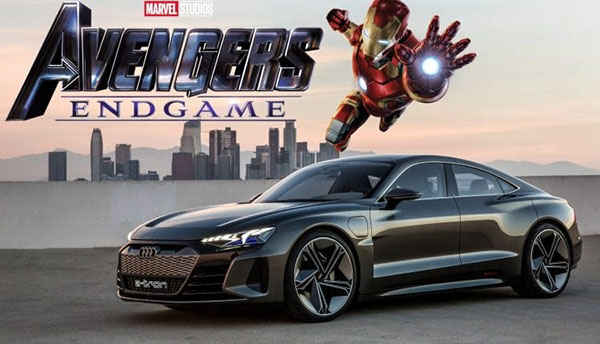
Source: animatedtimes.com
The electric car revolution that was much hyped a few years ago seems to be following a slower than anticipated trajectory. One of my blogs from back in June 2015 titled ‘The Germans are coming’ indicated numerous German e-car and plug-in hybrid offerings would be on the market by now. Fast forward 3.5 years, I (or the hype), seem to have portrayed a more ambitious timeline than has actually come to pass. The offerings by other automakers seem to be appearing on the lots of dealers at a trickle, not a deluge and even the launch of the much-anticipated Tesla mainstream “affordable” Model 3 was delayed a few times. Only now do I finally see them or the older versions on nearly a daily basis in Calgary.
Passing by a newsstand the other day, I picked up a copy of the latest ‘Car and Driver’ and was pleased to see three new electric cars on the cover, however the issue was titled ’25 cars worth waiting for’. Generally, the goal of this type of magazine (and that of their supporting advertisers) is to get readers excited about the latest vehicles that are available today, and not encourage potential customers to wait a year or two. As an occasional reader of Car and Driver over the years, I recall that there was once a time when the automotive journalists at the magazine would consider the requirement for a ‘real car’ to have a 6-speed manual transmission a powerful gasoline engine and a German badge on the front. While it is telling that the automotive purists that produce this popular magazine are now acknowledging electric cars as a credible option, by featuring three new models on the cover, they are still saying that buyers should wait. Among the 25 vehicles that the magazine suggests waiting for are 9 electric models, including a full-size electric powered pickup truck and large SUV from an American start-up called Rivian, a new Audi e-tron electric and an electric variant of the popular Ford Mustang in a more family friendly four-door format.
The automotive world has always been slow to adapt to new technology, but it is starting to come around. Features like cassette decks and CD players remained as standard features in cars, well past the obsolescence of these formats. Similarly, onboard navigation systems that relied on DVDs requiring yearly manual updating and were inevitably out of date by the time the car hit the dealer’s lot, continued until the advent of Bluetooth technologies like Apple’s Carplay and integrated Google Maps. Despite being available on smartphones long ago, these features have only appeared as standard car options in the last few years. The incumbent automotive companies seem to cling to what works and is cheap to produce, so handing over the onboard technology to the likes of Apple and Google seems like a logical way to keep things up to date.
As it is the case with most disruptive technologies, it takes a small company that is willing to risks complete failure to bring new technologies to the forefront. This is generally followed by a takeover bid by a large incumbent company often with market share of the industry to bring the new technology to the mass market or risk getting left behind.
1 — Ford F-series (909,330 units sold)
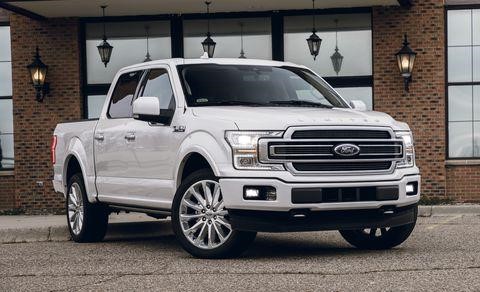
Source: caranddriver.com
Tesla and its outspoken CEO Elon Musk seem to be masters of courting publicity (and their share of controversy) but another American electric car start-up called Rivian stole the spotlight at the recent Detroit auto show. Rivian has focused its efforts on developing two vehicles in the popular SUV/Truck market which is likely a smart strategic play. Seemingly pitched as a direct rival, a display for the new Rivian R1T all electric truck was set up directly across from Ford’s F-150 display, attracting plenty of attention from the market of curious truck buyers. Of the top 25 best-selling vehicles in the US last year, 17 of the 25 were trucks or SUVs. The number one selling vehicle for the last several years was Ford’s F150 that sold over 900,000 units or nearly 3 times more than the highest selling passenger car, the Toyota Camry, that sold just over 300,000 units in the US in 2018. Pick-up trucks make up the top three selling vehicles in the US: the Chevrolet Silverado/GMC Sierra, the Dodge Ram, and the top ranked F-150. Each of these are generally Chevy, Dodge and Ford’s most lucrative product line. While Tesla has hinted at a future truck offering, Rivian already has a working model that will be ready for production by late 2020. Targeting the largest selling segment of vehicles in the US (combined sales of the top three pick-up trucks totals over 2 million units in the US alone with mid to large SUVs close behind) is a strategy that covers the largest number of potential US buyers.
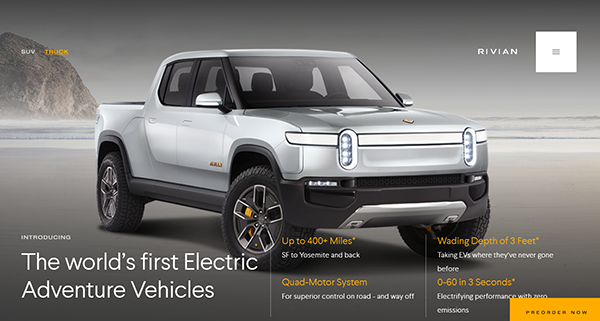
Source: Rivian.com
To get a bit technical, Rivian has taken the benefits of an electric drivetrain and applied it to a truck platform. The new R1T features include a range of up to 400 miles (nearly 640km) and 0-60 mph (0-100km/h) acceleration in the low 3 second range. This type of acceleration will rival most super-cars on the market today and comes as a result of 4 independent electric motors, one driving each wheel powered by a massive 180kwh battery (more than 2x as big as the standard battery in today’s Teslas). Rivian will offer a pick-up truck format as well as a large 8 passenger SUV that built on the same battery/motor underpinnings as its pickup truck sibling.
The tremendous off-road capabilities of the Rivian vehicles (features that will rarely be used by buyers of a $100,000 SUV) were also highlighted at the auto show. The independent motors allow for near perfect electronic delivery of power to all four wheels combined with massive torque at low speeds allowing the vehicle to traverse incredibly rough terrain and climb hills up to a 45-degree angle. The sealed battery and motor units also allow it to cross a river over 1m deep without worry of water getting into engine air intakes, as is an issue in a combustion engine vehicle. The Rivian representative at the auto show said the limiting factor wasn’t the depth of the water over the vehicle, but the fact that the vehicle is so well sealed, that if it entered water that was too deep, it would start to float! They went on to suggest that the SUV could actually pass through much deeper water if it was filled with a heavier load, though this wasn’t recommended.
Perhaps a submarine feature is the next iteration from Tesla to keep up in the electric automotive arms race. I’m sure it has crossed the mind of Tesla engineers as evidenced by the virtual submarine feature they built into the latest Model S update (?). he graphics on the onboard display change to resemble the famous submarine Lotus from the James Bond movie ‘The Spy Who Loved Me’ after Elon Musk purchased the prop car at auction as a collector’s item.
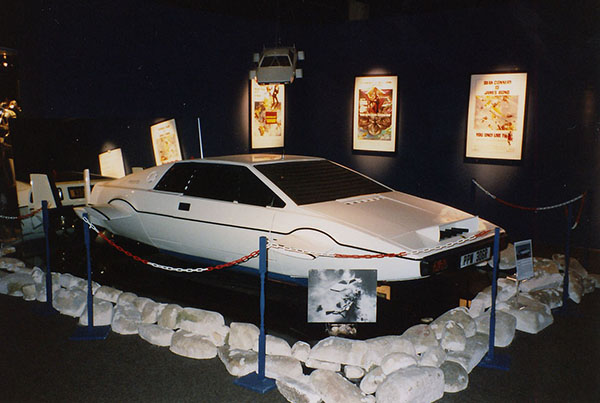
Source: Wikipedia.com
The sales of Tesla’s Model X SUV have been relatively slow as a mainstream vehicle as it is priced well out of range of most buyers. A well-equipped Model X (with long-range battery and some basic options) will cost a Canadian buyer in the range of $CAD 130,000-$140,000. Upgrading to the performance package and features like autopilot runs the price up well beyond that. By comparison, a similarly sized and equipped SUV from a luxury brands like Mercedes or Audi will run in the $CAD 75,000-$85,000 range and mid-prices SUVs from the likes of Ford, GM, Honda or Toyota are half as much again. The other feature that may have turned SUV buyers with an active lifestyle away from the Model X is that is that the design of the ‘Falcon-wing’ back doors that prevent the addition of any type of roof rack for carrying bikes or skis on top of the vehicle. The falcon wing doors are indeed very cool and give it the appearance of entering a space ship, but they added greatly to the cost and complexity of the vehicle and limit the use as a practical everyday SUV.
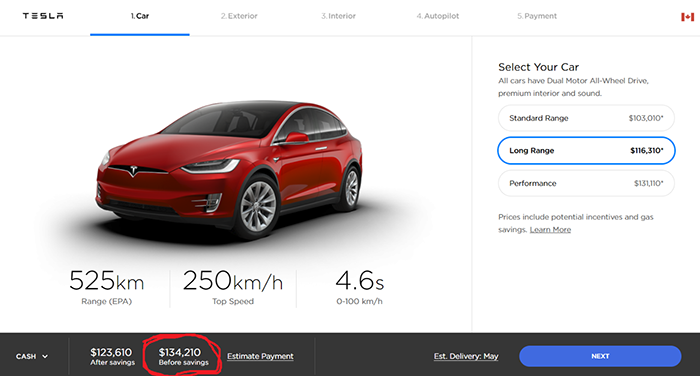
Source: Tesla.com (CAD pricing)
A headline broke last week that Amazon and Ford had each invested $US 700 million and $US 500 million respectively, in the latest financing round for Rivian. In exchange for this investment Ford will be allowed to nominate one board member to Rivian’s board of directors. For Ford, it seems that they see this upstart as a real threat and is looking to keep a close eye on the company or perhaps align itself as friendly take-over bidder down the road. For Amazon it could be simply another front in the ongoing ego battle between Jeff Bezos and Elon Musk, but this is just speculation. Both Bezos and Musk have engaged in battles on Twitter over the achievements of each other’s space companies Blue Origin and SpaceX so it seems natural that they the battleground would be extended to the automotive sector and Musk’s home turf.
Back to the Avengers movie… (minor spoiler alert) Back in the days of the Iron Man franchise, Elon Musk garnered a speaking role and cameo in the second Iron Man installment where Tony Stark (the fictional technological genius/superhero) and Elon Musk(playing himself), share a brief exchange at a restaurant where Musk pitches Stark on an idea for an electric jet. The background behind the cameo is that Musk has often been revered as a real-life Tony Stark as credit to his numerous technology companies ranging from Paypal to SpaceX to Tesla (not to mention his quirky personality). In the latest installment of the ‘Avengers Endgame’, Tony Stark arrives in dramatic fashion driving a version of Audi’s latest e-Tron electric car that closely resembles Tesla’s Model S, for a few moments of gratuitous product placement. The new e-Tron will likely be a strong challenger to Tesla’s original flagship Model S sedan that has enjoyed an exclusive spot in the market as the only full-size electric sedan for nearly a decade. One wonders how it took so long for the first credible challenger to arrive from any other automaker. For the sake of the movie, the electric car makes some cool sounding electric engine noises, like a science fiction space-ship, but as with most electric cars, it should be nearly silent when the vehicle hits the roads in real life. This is the same e-Tron that is on the cover of this month’s Car and Driver and it appears that the product placement and hype for the new e-Tron is a shot from Audi directly targeted at the science-fiction loving and technologically savvy audience of the latest installment in the Avengers franchise. That’s all that I will say about Avenger’s Endgame for fear of revealing any details that are actually important to the plot and annoying you if you haven’t yet seen it yet.
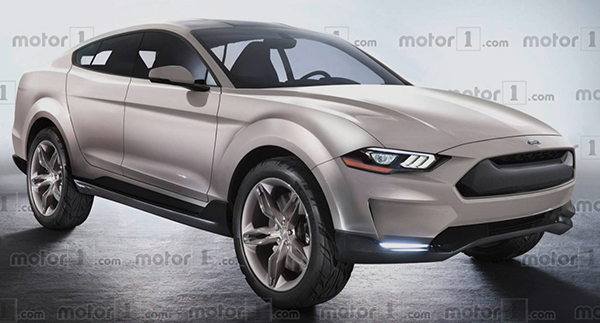
Source: motor1.com
The third vehicle on the cover of Car and Driver was Ford’s Mustang electric variant that has four doors, a hatchback and appears to have very similar specs to the Tesla Model 3. While the truck and SUV market are the largest and most lucrative markets in the US, the passenger car market shouldn’t be ignored either. For Ford, the temptation to exploit the capabilities of the electric platform may prove too much to resist.
By comparison, the Tesla Model 3 with the performance package can match the acceleration and handling of many performance and muscle cars that cost twice as much. The addition of ‘Track Mode’ on the latest version of the Tesla Model 3 with the performance package showed it beating the famed BMW M3, Mercedes AMG C Class and a number of other high-performance cars in a recent test of track lap times by Motor Trend. Tesla did this by altering the traction control systems to optimize for cornering and allowing the tires to drift enough to corner faster than the standard traction control. Electric cars have been dominating drag races for since the advent of ‘Ludicrous mode’ on Tesla’s Model S, as the torque and power delivery of an all-wheel drive electric platform is hard to beat, but the latest iteration takes full advantage of handling performance potential of an electric platform for driving conditions other than straight line acceleration from a standing start. I’m sure that the potential of their new electric platform isn’t lost on the engineers at Ford and I would wager that we will see a performance electric version of the upcoming Mustang model that rivals the combustion powered version in a few years.
The competition is heating up in the electric car market and in the next 18 months, there will likely be number of options to challenge the status quo as competition from a number of incumbents and start-ups alike will have joined the party. But, as the headline from the latest Car and Driver indicates, it is probably worth waiting.
The opinions expressed in this report are the opinions of the author and readers should not assume they reflect the opinions or recommendations of Richardson GMP Limited or its affiliates.
Richardson GMP Limited, Member Canadian Investor Protection Fund. Richardson is a trade-mark of James Richardson & Sons, Limited. GMP is a registered trade-mark of GMP Securities L.P. Both used under license by Richardson GMP Limited.